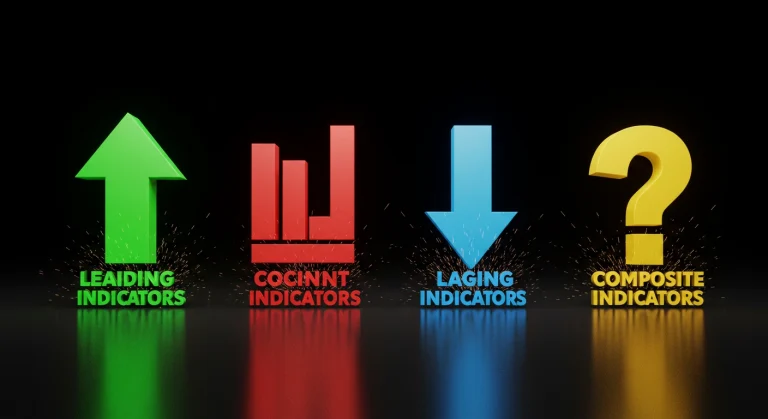What are the 4 types of economic indicators? Understanding the dynamics of these indicators is crucial for anyone involved in economic planning or forecasting. Economic indicators serve as the backbone of data-driven analysis, guiding decisions made by governments, businesses, and investors. By classifying these indicators, we can better interpret the health of an economy and its potential trajectory.
In today’s rapidly changing financial landscape, staying informed is more important than ever. Economic indicators provide insights into consumer behavior, production levels, and overall economic confidence. Whether you’re a seasoned economist or an interested novice, grasping the types of economic indicators is a gateway to understanding more complex economic theories and applications.
This article delves into the four main types of economic indicators: leading, lagging, coincident, and composite. Each plays an integral role in economic analysis and affects planning and strategy. Let’s explore these categories, their definitions, examples, and significance, ensuring you have a detailed understanding of what governs the economic environment.
Equipped with this knowledge, you will be empowered to make informed decisions, understand market trends, and interpret economic reports with confidence. Let’s engage with these indicators and unlock the value they add to our understanding of economics.
Leading Economic Indicators
Leading economic indicators are metrics that tend to change before the economy as a whole changes. These indicators are vital for forecasting future economic activity, offering a glimpse into how various sectors might perform.
Examples of Leading Indicators
- Stock Market Performance: Often viewed as a predictor of future economic health, stock prices tend to rise as companies anticipate higher profits.
- New Business Startups: An increase in new businesses can signal economic confidence and robustness.
- Consumer Confidence Index (CCI): This index gauges how optimistic consumers feel about their financial situation, influencing their spending behaviors.
Lagging Economic Indicators
Lagging economic indicators are metrics that follow an event and confirm trends long after they occur. They are essential for illustrating the overall health of the economy after a shift has already happened.
Examples of Lagging Indicators
- Unemployment Rate: This statistic often highlights trends only after they have significantly impacted the economy.
- Corporate Profits: Changes in corporate profitability are typically reported after the earning periods have concluded.
- Gross Domestic Product (GDP): GDP represents the total economic output and is revised for accuracy after new data comes in.
Coincident Economic Indicators
Coincident economic indicators move in sync with the overall economy, providing real-time insights into the current state of economic activity. They reflect the current plateau of economic behaviors and trends.
Examples of Coincident Indicators
- Employment Levels: The number of people employed remains constant with the health of the economy.
- Industrial Production: This measures the output of the industrial sector and correlates with the economy’s performance.
- Personal Income: Changes in personal income levels directly relate to economic growth and consumption.
Composite Economic Indicators
Composite economic indicators synthesize various individual indicators to provide a broader view of economic conditions. These aggregates help analysts and policymakers understand complex relationships.
Examples of Composite Indicators
- Leading Economic Index (LEI): This index combines ten leading economic indicators, producing a single number for better forecasting.
- Consumer Price Index (CPI): As a composite measure of inflation, CPI tracks the price changes of a basket of goods and services.
- Purchasing Managers’ Index (PMI): This indicator compiles data from purchasing managers, providing insights into economic activity and market sentiment.
The Importance of Economic Indicators
Understanding economic indicators is crucial for making informed decisions. They help businesses strategize, investors allocate resources, and policymakers formulate sound economic policies. Each type of indicator informs different sectors of the economy, allowing varied stakeholders to build a comprehensive picture of economic health.
Strategic Applications
Using these indicators strategically enables organizations to adapt to changing market conditions. For instance, a spike in leading indicators might prompt businesses to ramp up production in anticipation of heightened demand. Conversely, a surge in lagging indicators may signal the need for reevaluation of current strategies to align with economic realities.
Conclusion
In summary, the four types of economic indicators—leading, lagging, coincident, and composite—serve essential roles in economic analysis. By leveraging this knowledge, individuals and organizations can navigate the economic landscape with greater confidence and agility. Understanding these indicators not only aids in predicting trends but also enhances decision-making processes across various economic sectors.

Useful links
Conclusion
In summary, understanding the four types of economic indicators is essential for anyone looking to grasp the intricacies of economic analysis. Leading, lagging, coincident, and composite indicators each play a distinct role in providing insights about economic performance and future trends. By identifying the right indicators, investors, policymakers, and businesses can make informed decisions that positively impact their strategies and operations.
The synergy between these indicators enhances their effectiveness. For instance, while leading indicators forecast future economic activity, lagging indicators confirm the trends that have already emerged. Coincident indicators bridge the gap between leading and lagging, while composite indicators offer a comprehensive view by combining multiple data sources. This interconnectedness underscores the importance of a holistic approach in economic evaluation.
Ultimately, becoming proficient in interpreting these indicators not only equips individuals with the tools to make sound financial decisions but also fosters a deeper understanding of the economy’s dynamics. In a rapidly changing economic landscape, the ability to analyze these indicators can provide a competitive edge and promote strategic foresight, making it a vital competency in today’s world.
Perguntas Frequentes
What are leading indicators in economics?
Leading indicators are key economic metrics that tend to change before the economy starts to follow a particular trend. They serve as a predictive tool for economists and analysts, indicating future economic movements. Examples include stock market trends, consumer purchasing orders, and building permits. By analyzing these indicators, stakeholders can gauge upcoming economic expansions or contractions, allowing them to act proactively rather than reactively in their financial and business strategies.
What are lagging indicators and how are they used?
Lagging indicators are metrics that reflect the economic performance of an economy after changes have occurred. They often confirm long-term trends and are utilized to analyze past economic developments. Common lagging indicators include unemployment rates, GDP growth, and corporate profits. By examining these indicators, businesses and policymakers can understand the implications of past economic conditions, enabling them to adjust strategies accordingly for future stability.
What are coincident indicators and their significance?
Coincident indicators move in tandem with the overall economy and provide a real-time snapshot of current economic activity. These indicators include metrics like personal income, industrial production, and retail sales. Their significance lies in their ability to directly reflect the current state of the economy, making them invaluable for stakeholders seeking to assess the present economic context and make informed decisions based on real-time data.
What are composite indicators and how do they differ?
Composite indicators are aggregates of various individual indicators that collectively provide a broader perspective of economic conditions. They can factor in elements from leading, lagging, and coincident indicators. An example is the Index of Leading Economic Indicators (LEI), which combines multiple metrics into a single gauge. This comprehensive approach aids analysts and decision-makers in gaining a well-rounded understanding of economic trends, rather than relying on isolated data points.
How can economic indicators guide investment decisions?
Economic indicators can significantly influence investment decisions by providing insights into market trends and potential risks. By analyzing leading indicators, investors can identify growth opportunities, while lagging indicators can help them understand economic stability and risks. Coincident indicators provide current operational context, helping investors ascertain whether to enter or exit specific markets. Together, these indicators form a robust framework that investors can use to refine their strategies in line with economic conditions.
Why is it important to analyze economic indicators together?
Analyzing economic indicators collectively enhances their interpretative value. Each type of indicator offers unique insights; leading indicators hint at future trends, lagging indicators validate historical changes, and coincident indicators provide current context. By considering these indicators together, stakeholders can make more accurate predictions and informed decisions, leading to a strategic advantage in navigating economic cycles and uncertainties.
How often are economic indicators updated?
The frequency of updates for economic indicators varies widely depending on the type and source. Leading indicators like stock market performance may be updated daily, whereas lagging indicators such as GDP growth are typically released quarterly. Coincident indicators may also be produced monthly or quarterly. Regular updates allow analysts and decision-makers to stay attuned to changes in economic conditions, making timely and informed decisions based on the most current data available.


